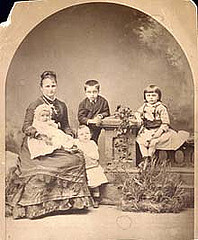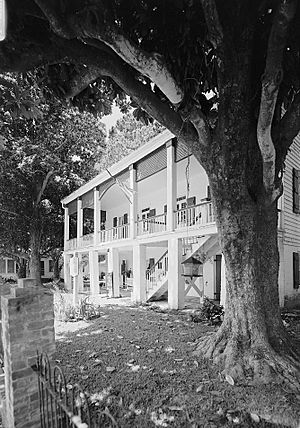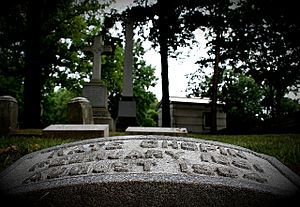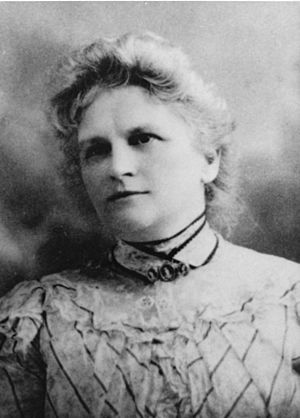Kate Chopin facts for kids
Quick facts for kids
Kate Chopin
|
|
|---|---|
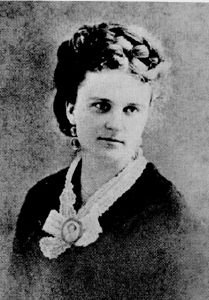
Chopin in 1894
|
|
| Born | Katherine O'Flaherty February 8, 1850 St. Louis, Missouri, U.S. |
| Died | August 22, 1904 (aged 54) St. Louis, Missouri, U.S. |
| Occupation | Novelist, short story writer |
| Genre | Realistic fiction |
| Notable works | The Awakening |
| Spouse |
|
| Children | 6 |
| Signature | |
 |
|
Kate Chopin (born Katherine O'Flaherty; February 8, 1850 – August 22, 1904) was an American writer. She wrote many short stories and novels. Her stories were often about life in Louisiana.
Many people see her as an early writer who explored women's independence. She is well-known for her novel The Awakening, published in 1899.
Kate Chopin was born in St. Louis, Missouri. Her family had French and Irish roots. She married and moved to New Orleans. Later, she lived in the countryside in Cloutierville, Louisiana.
From 1892 to 1895, Chopin wrote stories for both kids and adults. These stories appeared in popular magazines like Atlantic Monthly and Vogue. Some of her stories caused debate because they talked about topics that were not usually discussed at the time. Some people thought her stories were not proper.
Her main works include two collections of short stories: Bayou Folk (1894) and A Night in Acadie (1897). Some of her famous short stories are "Désirée's Baby" (1893) and "The Story of an Hour" (1894). She also wrote two novels: At Fault (1890) and The Awakening (1899).
Most of her characters live in Louisiana. Many are Creoles, who have mixed backgrounds. Many of her stories are set in Natchitoches, where she lived.
After her death, Kate Chopin became known as an important writer. People recognized her talent for telling stories.
Contents
Kate Chopin's Early Life
Kate Chopin was born Katherine O'Flaherty in St. Louis, Missouri. Her father, Thomas O'Flaherty, was a successful businessman from Ireland. Her mother, Eliza Faris, was from a French family in St. Louis.
Kate was the third of five children. Sadly, her sisters died when they were babies. Her older half-brothers also passed away in their early 20s. Kate grew up in a Catholic family. She loved to read fairy tales, poems, and novels. She finished school at Sacred Heart Convent in St. Louis in 1868.
When she was five, Kate went to Sacred Heart Academy. The nuns there taught her to be independent. After her father died, she lived with her grandmother and great-grandmother. These three generations of women were all widows who did not remarry.
For two years, her great-grandmother, Victoria Charleville, taught her at home. She learned French, music, history, and how to face life without fear. Kate then returned to Sacred Heart Academy. Her best friend, Kitty Garesche, also went there. Her teacher, Mary O'Meara, encouraged Kate to write often and to be brave.
In May 1861, the American Civil War began in St. Louis. During the war, Kate's half-brother died. Her great-grandmother also passed away. After the war, Kitty's family had to leave St. Louis because they supported the Confederacy.
Moving to Louisiana
On June 8, 1870, Kate married Oscar Chopin in St. Louis. They moved to his hometown of New Orleans. Between 1871 and 1879, they had six children: Jean Baptiste, Oscar Charles, George Francis, Frederick, Felix Andrew, and Lélia.
In 1879, Oscar Chopin's cotton business failed. The family left New Orleans and moved to Cloutierville. There, they managed farms and a general store. Kate found many ideas for her stories in the local Creole culture.
Oscar Chopin died in 1882. Kate was left with debts. For a while, she managed his business. Two years later, she sold her Louisiana business. Her mother asked her to move back to St. Louis. Kate did, with her mother's help. Her children settled into city life. However, Kate's mother died the next year.
Kate felt very sad after losing her husband, her business, and her mother. Her doctor and family friend, Dr. Frederick Kolbenheyer, suggested she start writing. He thought it would help her feel better. He also believed it could be a way for her to use her energy and earn money.
Kate Chopin's Writing Career
By the early 1890s, Kate Chopin's short stories and articles were being published. They appeared in newspapers like the St. Louis Post-Dispatch and in literary magazines. At that time, many writers focused on local stories and dialects. Chopin was seen as a "local color" writer.
In 1899, her second novel, The Awakening, was published. Some critics liked the novel. However, many reviews were negative. Critics thought the characters, especially the women, behaved in ways that went against the rules of society.
This novel is now her most famous work. It tells the story of a woman who feels trapped by society's rules. For many years, the book was not printed. But in the 1970s, people rediscovered it. It is now widely available and praised for its writing. It is seen as an important early work that explored women's independence.
The negative reactions to The Awakening discouraged Chopin. She focused mostly on writing short stories after that. In 1900, she wrote "The Gentleman from New Orleans." She was also listed in the first edition of Marquis Who's Who. She did not earn much money from her writing. She lived on money she inherited from her mother.
On August 20, 1904, Kate Chopin visited the St. Louis World's Fair. She suffered a brain hemorrhage and died two days later, at age 54. She was buried in Calvary Cemetery in St. Louis.
What Kate Chopin Wrote About
Kate Chopin lived in different places with different ways of life. These experiences gave her ideas for her stories. She wrote about society in the late 1800s in the Southern United States. She grew up with French traditions. When she lived in Louisiana, she experienced Creole and Cajun cultures. Many of her stories are based on her life there.
Her stories often showed women as individuals with their own desires and needs. This was unusual for her time. For example, in "The Story of an Hour", a character named Mrs. Mallard thinks about her own feelings after hearing about her husband's death.
Not many writers in the 1800s were brave enough to write about the topics Chopin did. She believed that women were strong. Her stories explored the lives of individuals within their personal lives and society.
Chopin grew up during a time of big changes, like the movement to end slavery and the start of women's rights. Her stories showed the reality of her world. Some people today see her writing as an early voice for women's independence.
Early Stories
Kate Chopin's first story was published in the St. Louis Post-Dispatch. By the early 1890s, she was a successful writer. She wrote short stories and articles for local papers and literary magazines. Some of her early stories include "A Point at Issue!", "A No-Account Creole", and "Beyond the Bayou".
In 1890, her first novel, At Fault, was published. In 1892, she wrote "Désirée's Baby", "Ripe Figs", and "At the 'Cadian Ball". These stories were published in Two Tales.
The short story "Désirée's Baby" explores issues of race and identity in Louisiana. Kate Chopin grew up when slavery was common. In Louisiana, there were communities of free people of color. This story talks about the racism of the 1800s. People who looked white could be in danger if it was found out they had African ancestors. Chopin was not afraid to write about these difficult topics.
In 1893, she wrote "Madame Célestin's Divorce". Thirteen of her stories were published that year. In 1894, "The Story of an Hour" and "A Respectable Woman" appeared in Vogue.
Bayou Folk, a collection of 23 of Chopin's stories, was a success in 1894. It was her first work to get national attention. It was followed by A Night in Acadie (1897), another collection of short stories.
The Awakening Novel
Published in 1899, The Awakening was considered very modern for its time. It received more negative reviews than positive ones. This criticism made Chopin feel discouraged. After this, she mostly wrote short stories. The women characters in The Awakening did not follow the usual social rules of the time. Today, the novel is seen as an important book in the history of women's literature.
Kate Chopin in Other Media
Louisiana Public Broadcasting made a documentary about Kate Chopin's life. It is called Kate Chopin: A Reawakening.
Kate Chopin's Works
- "Bayou Folk" Read "Bayou Folk"
- "A Night in Acadie" Read "A Night in Acadie"
- "At the Cadian Ball" (1892) Read "At the Cadian Ball"
- "The Story of an Hour" (1894) Read "The Story of an Hour"
- "Désirée's Baby" (1895) Read "Désirée's Baby"
- "Emancipation: A Life Fable" Read "Emancipation: A Life Fable"
- "The Storm" (1898) Read "The Storm"
- "A Pair of Silk Stockings" Read "A Pair of Silk Stockings"
- "The Locket"
- "Athenaise" Read "Athenaise"
- "Lilacs" Read "Lilacs"
- "A Respectable Woman" Read "A Respectable Woman"
- "The Unexpected" Read "The Unexpected"
- "The Kiss" Read "The Kiss"
- "Beyond the Bayou" Read "Beyond the Bayou"
- "An No-Account Creole" Read "An No-Account Creole"
- The Awakening, and Selected Short Stories
- "Fedora"
- "Regret" Read "Regret"
- "Madame Célestin's Divorce" Read "Madame Célestin's Divorce"
- At Fault (1890), Nixon Jones Printing Co, St. Louis Read "At Fault"
- The Awakening (1899), H.S. Stone, Chicago Read "The Awakening"
- "An Egyptian Cigarette" (1900)
Awards and Recognition
- Kate Chopin's home in Cloutierville was built in the early 1800s. It was named the Kate Chopin House, a National Historic Landmark. This was because of her important writings. The house was used as the Bayou Folk Museum. Sadly, on October 1, 2008, the house was destroyed by a fire.
- In 1990, Chopin received a star on the St. Louis Walk of Fame.
- In 2012, a metal statue of her head was placed at the Writer's Corner in St. Louis.
See also
 In Spanish: Kate Chopin para niños
In Spanish: Kate Chopin para niños


